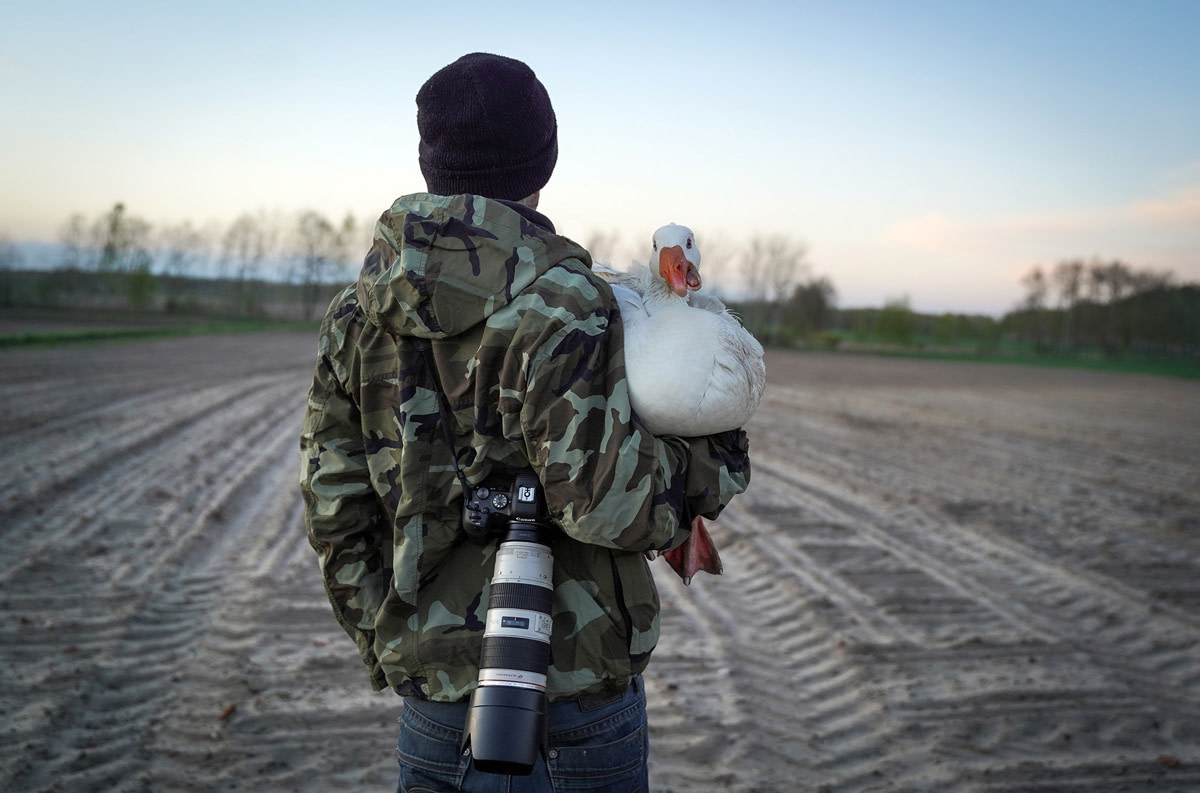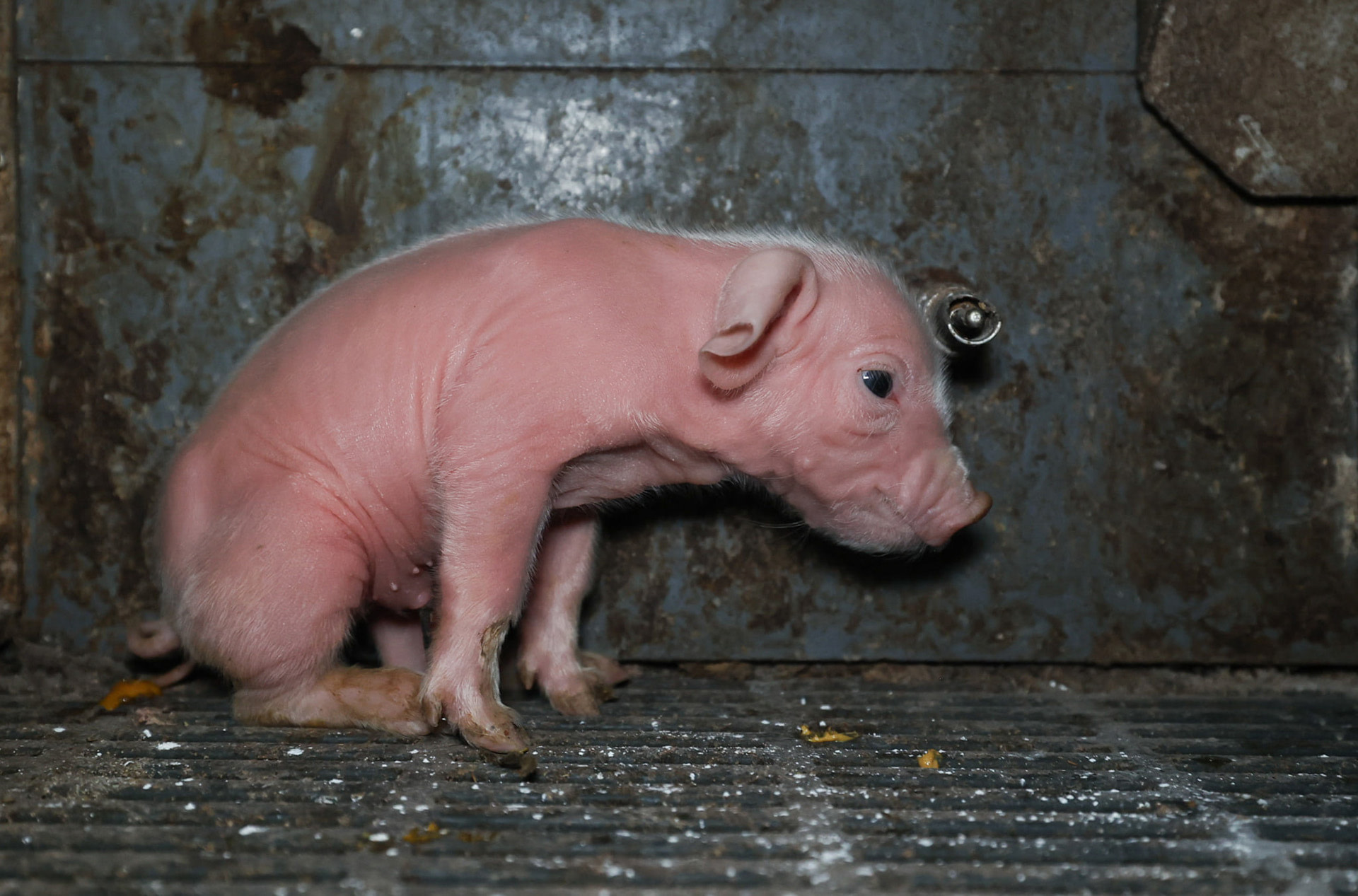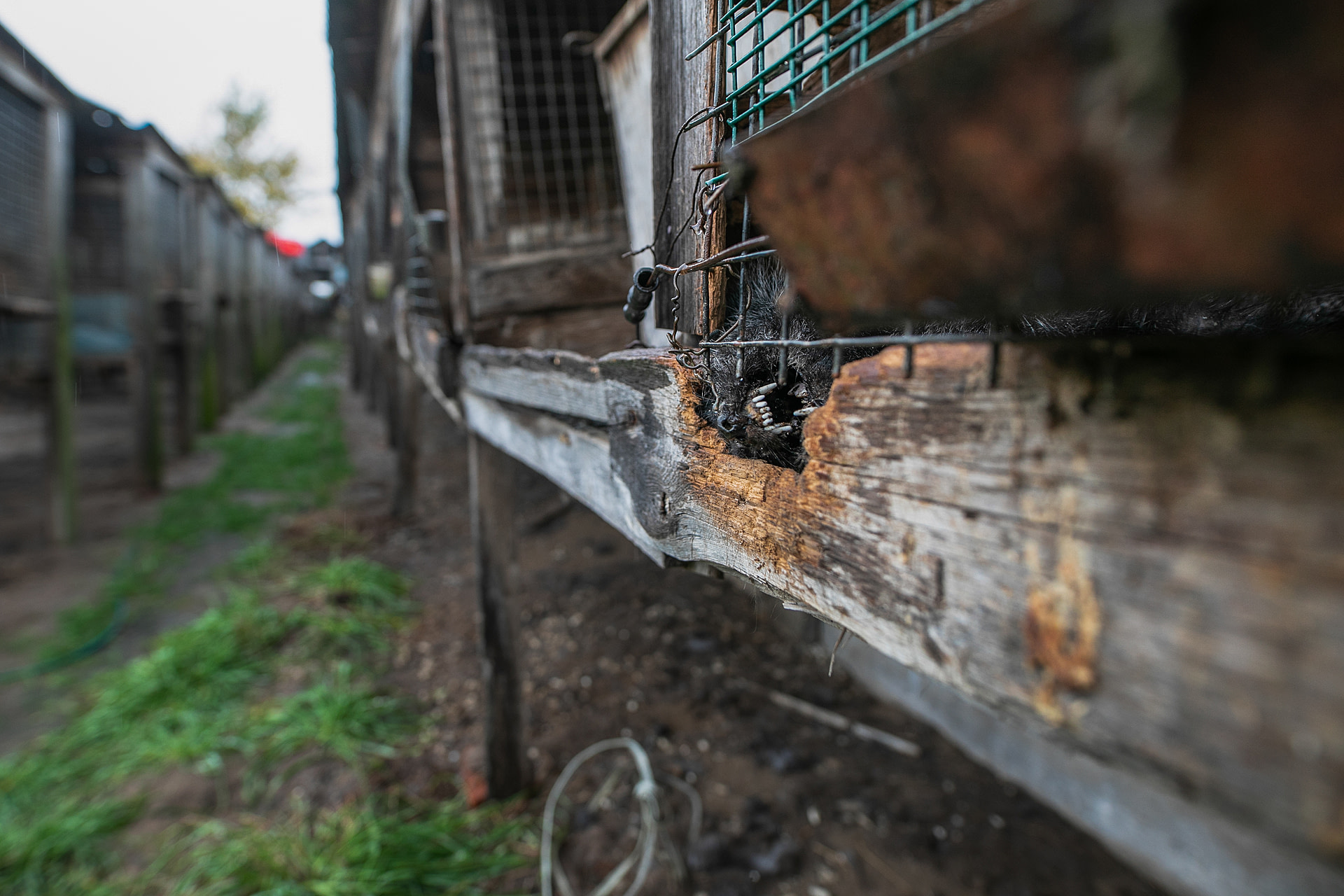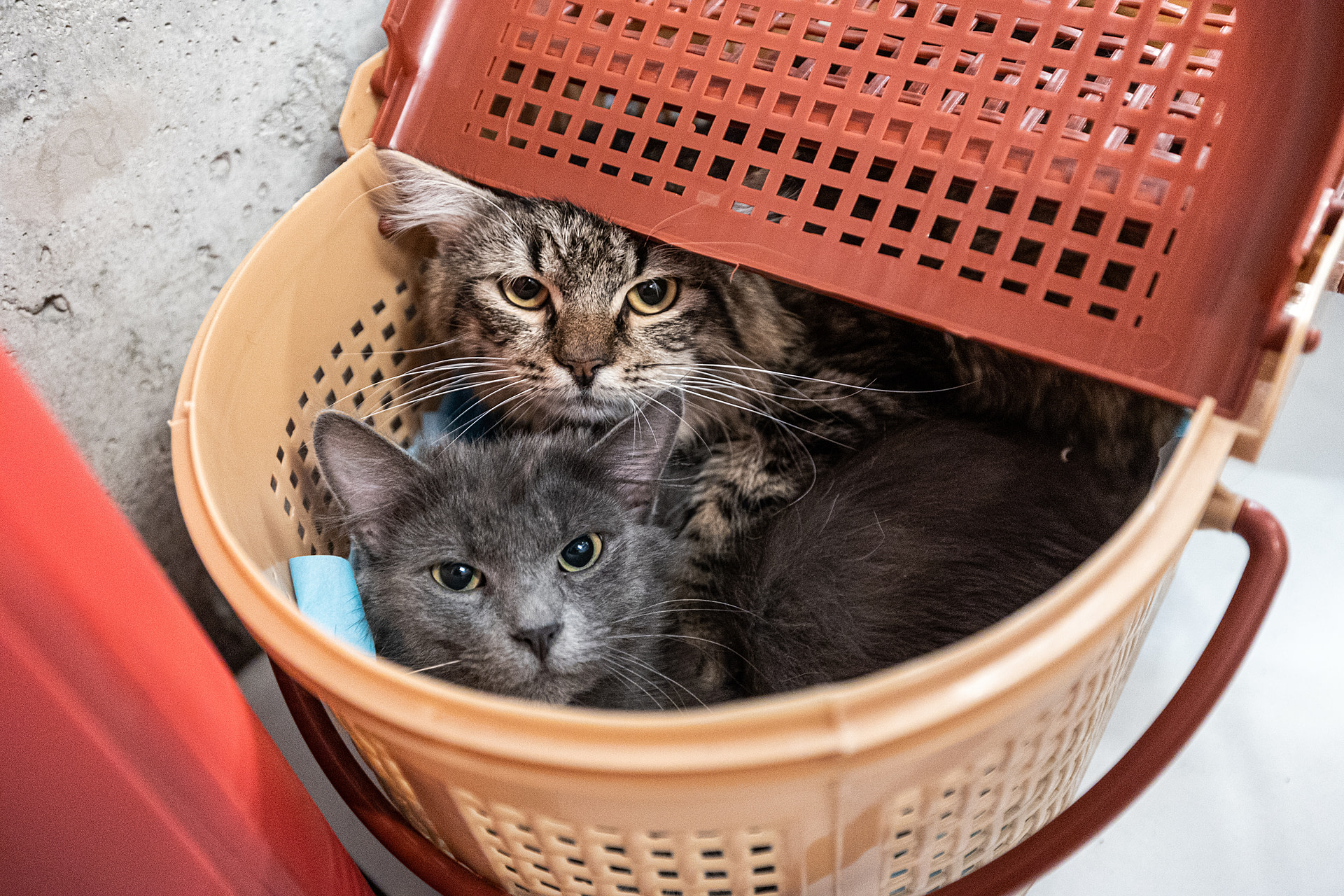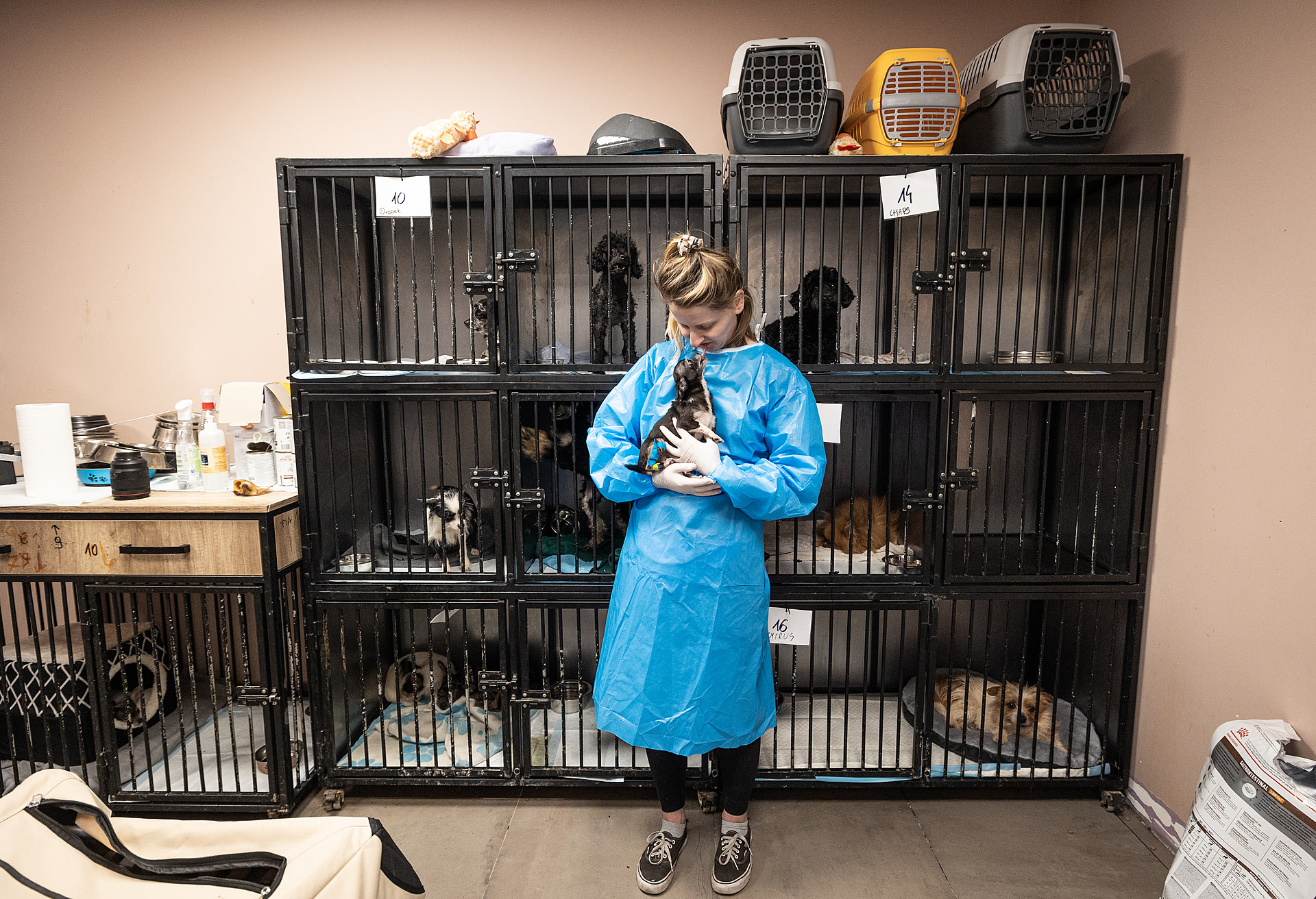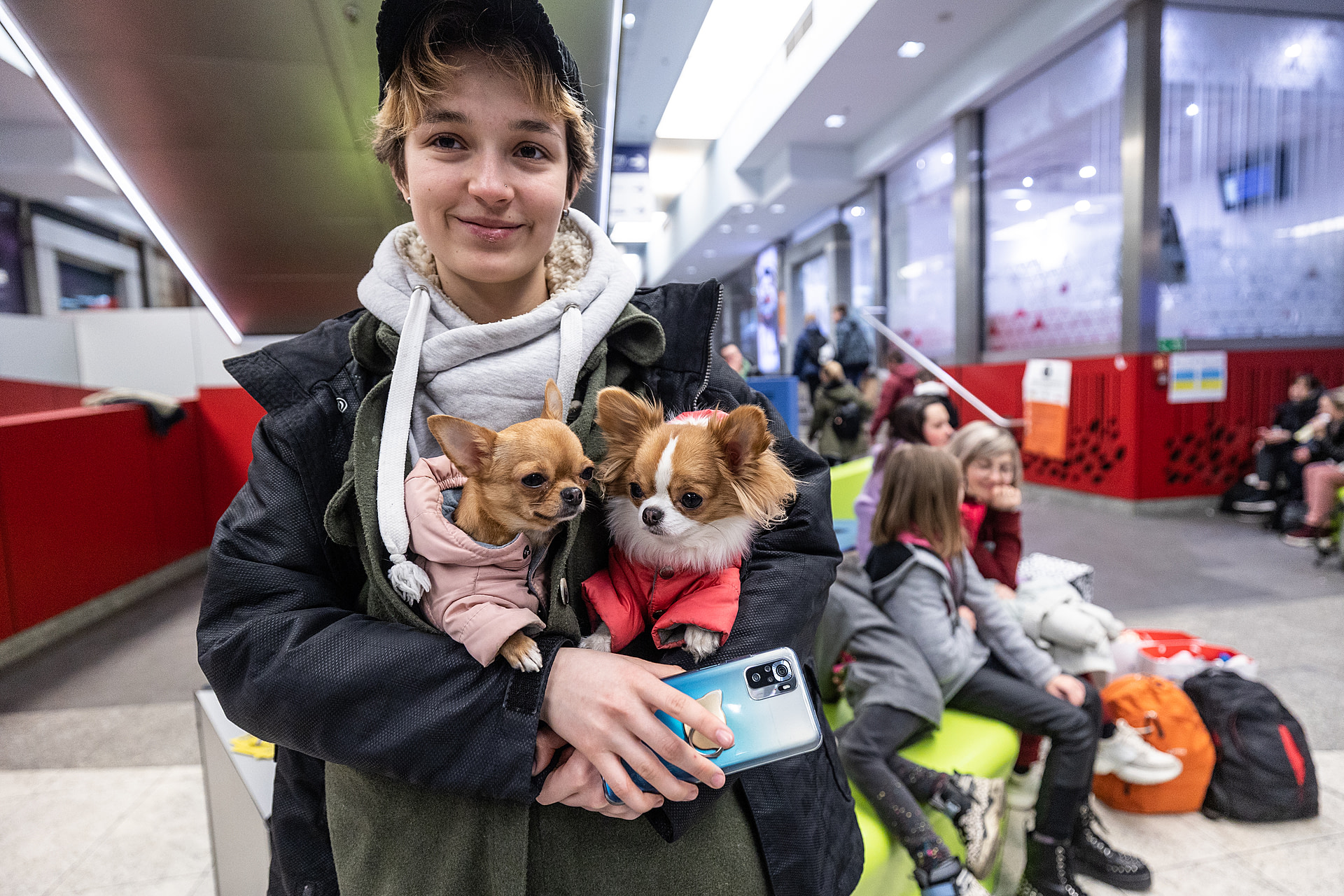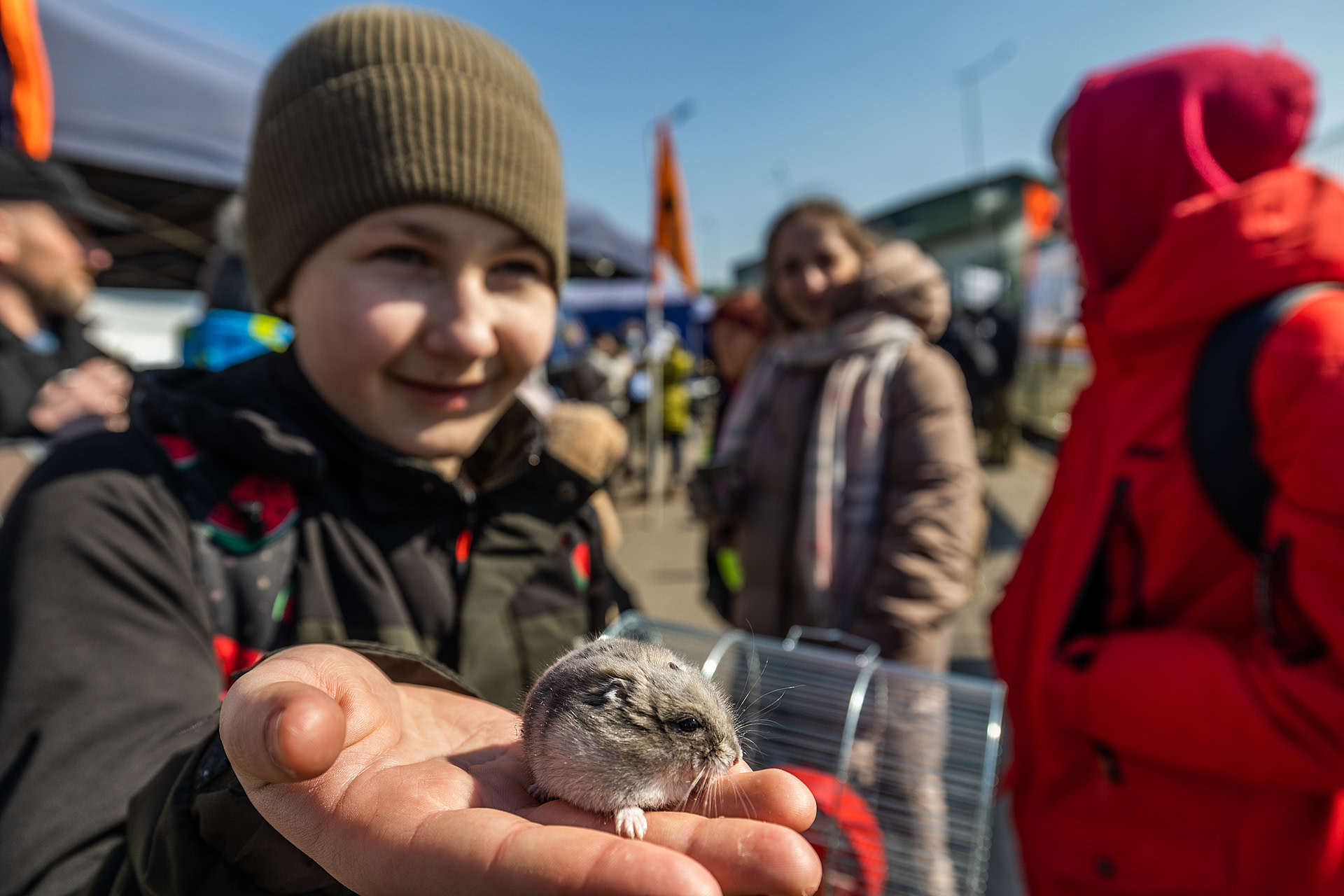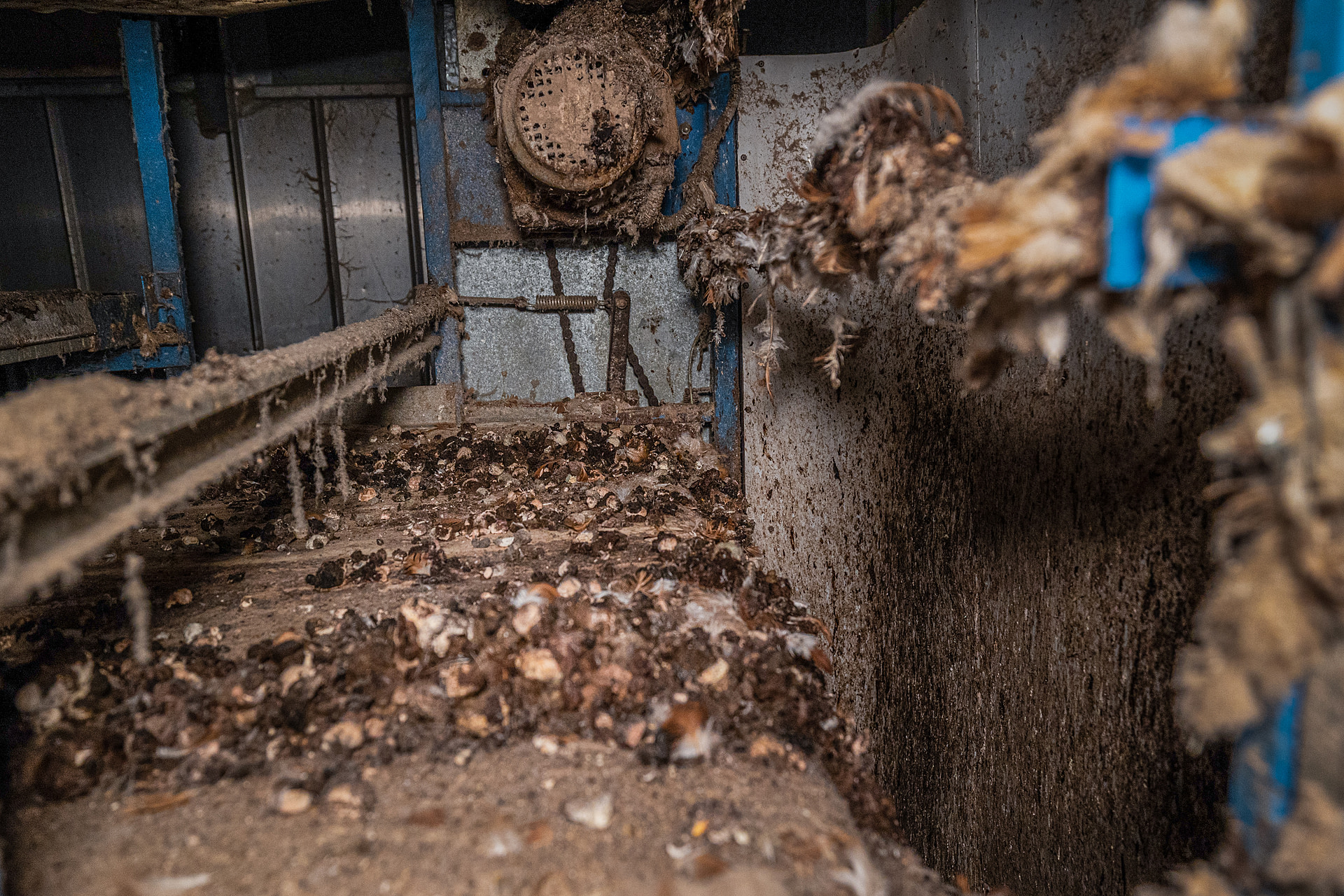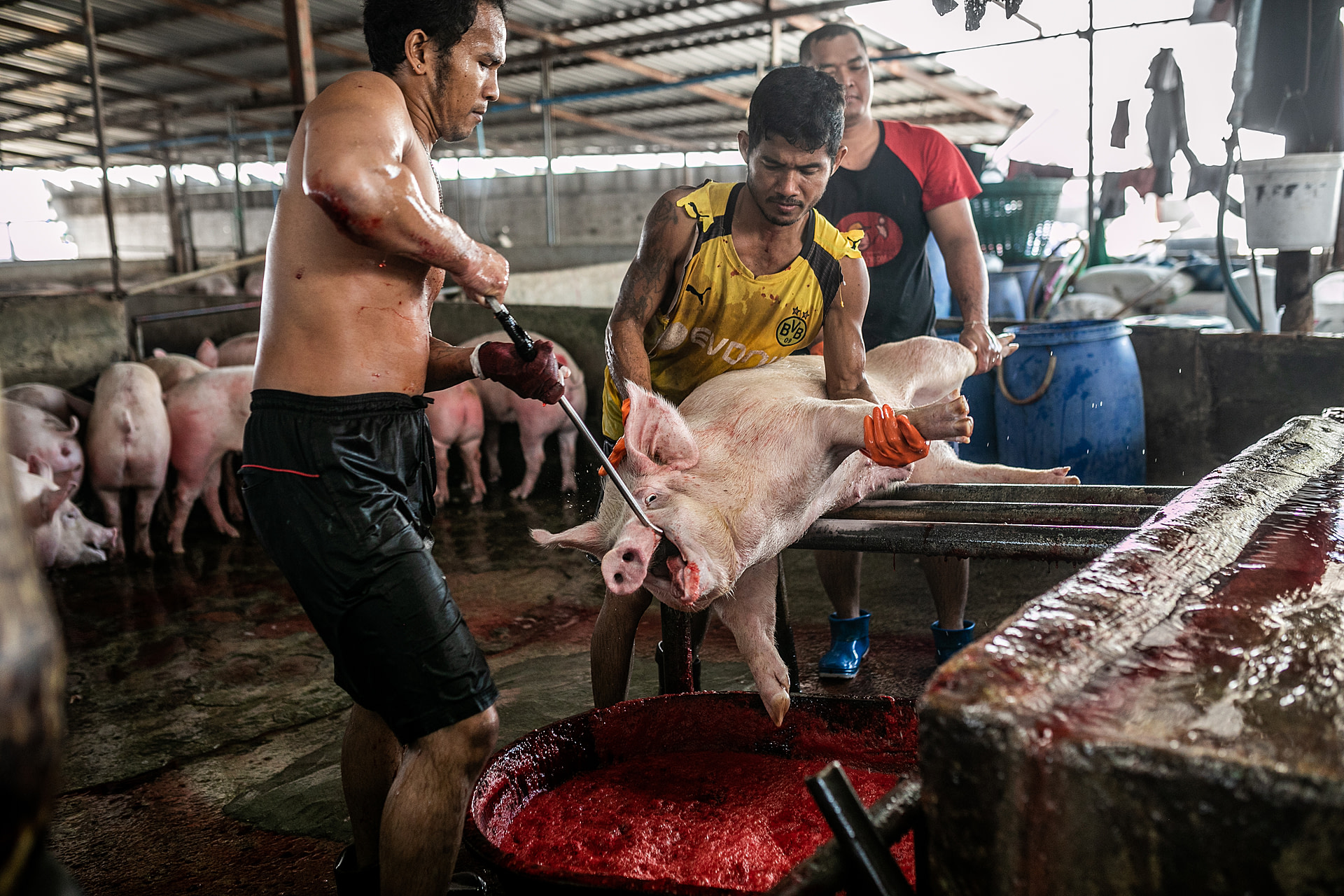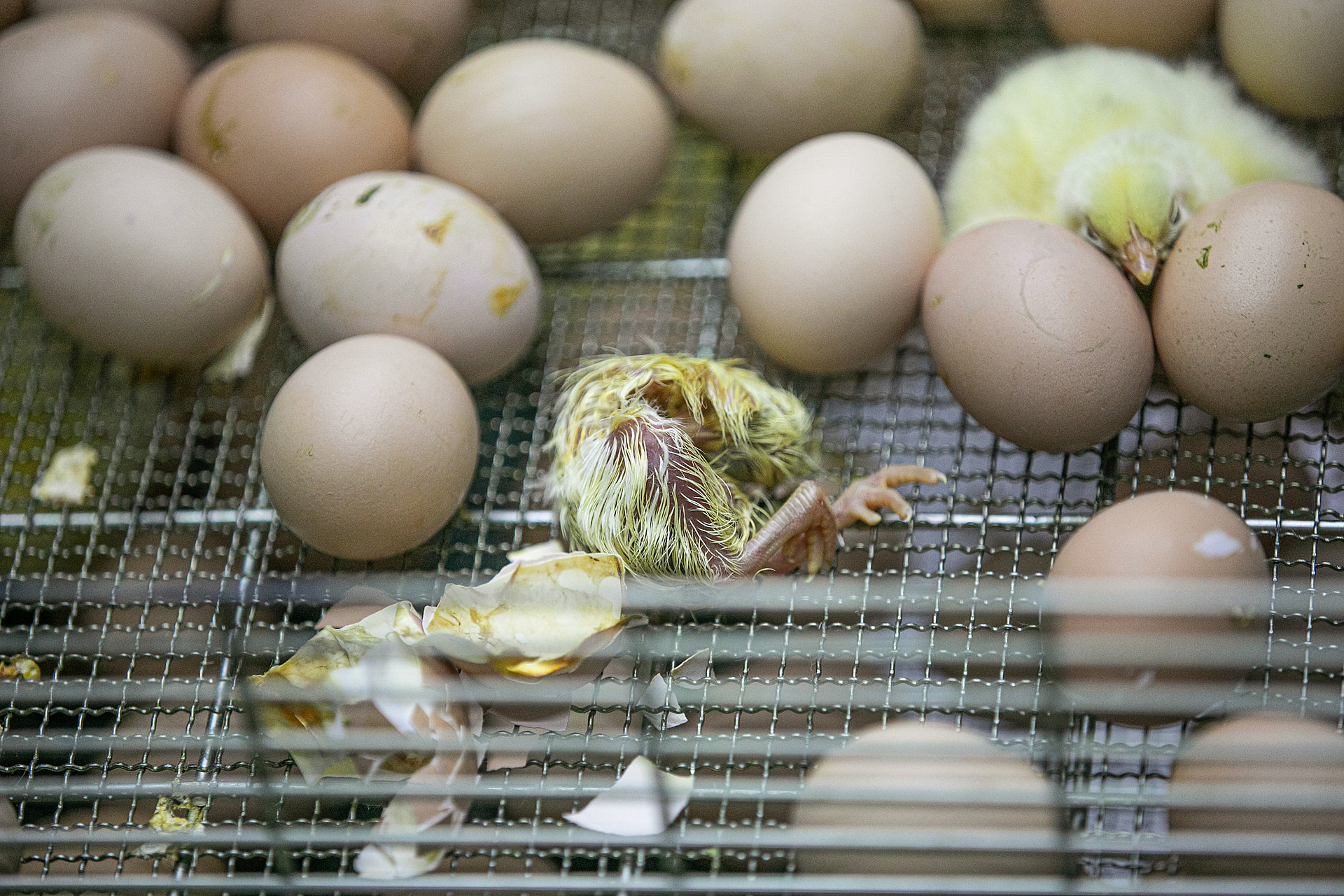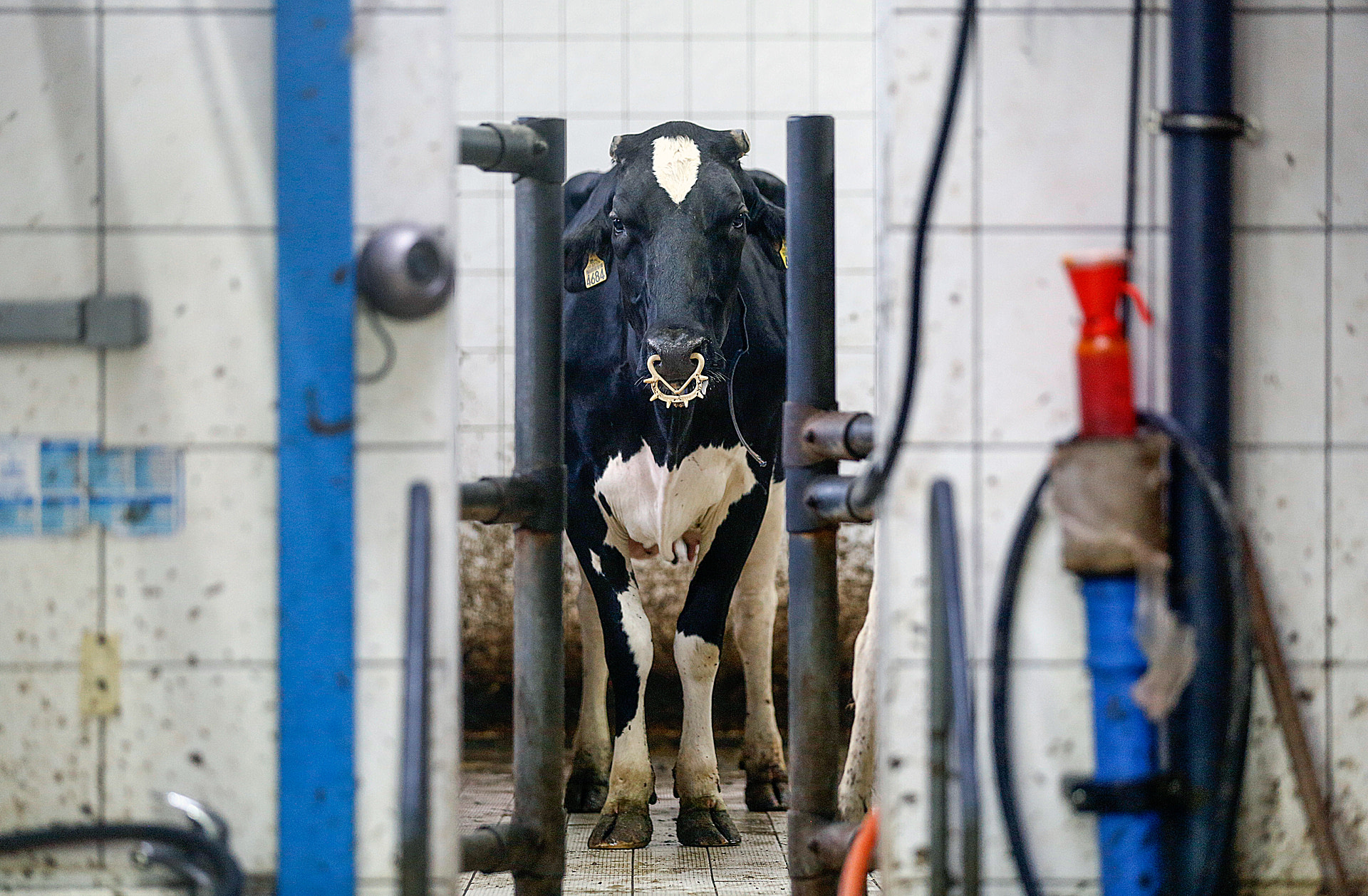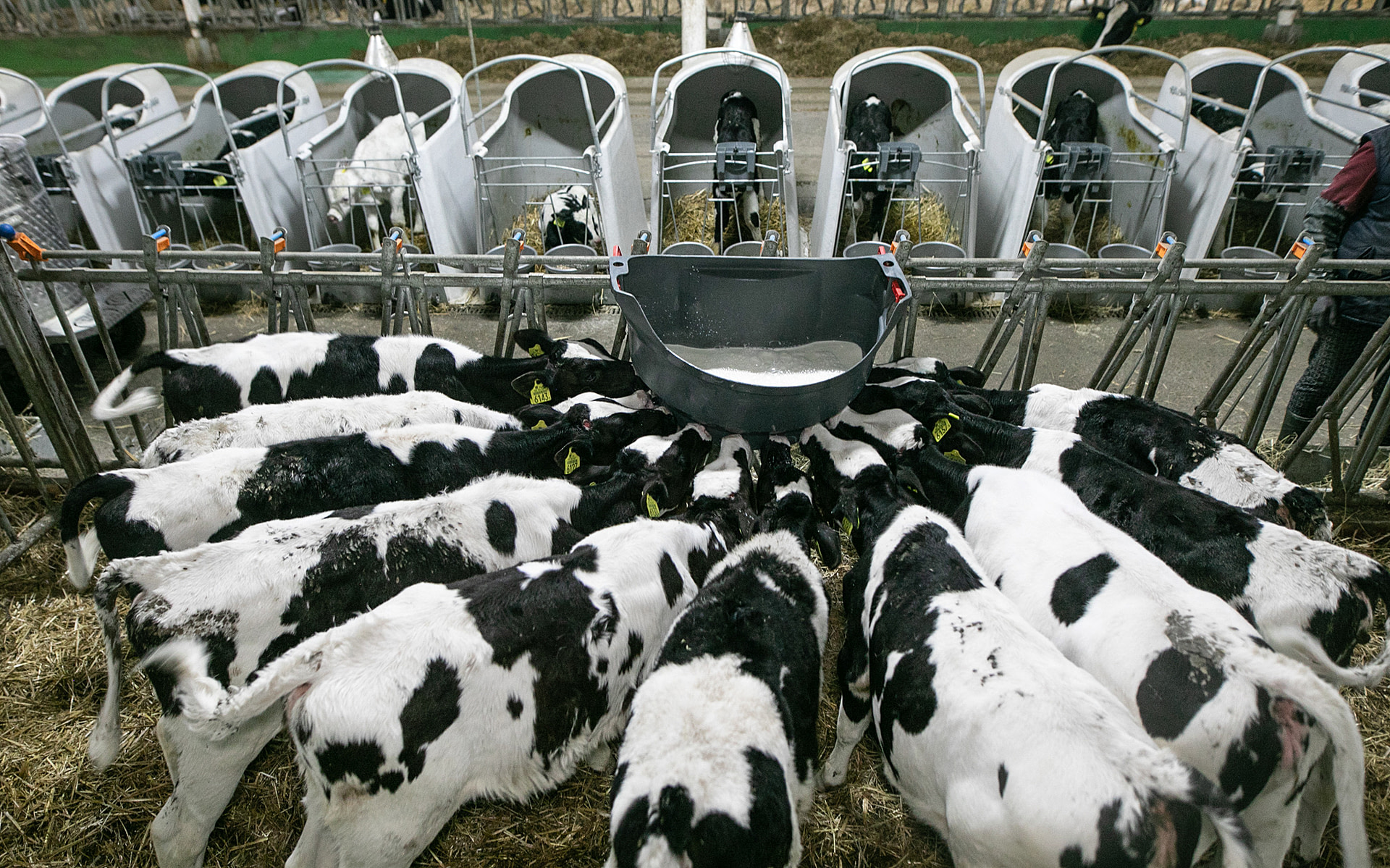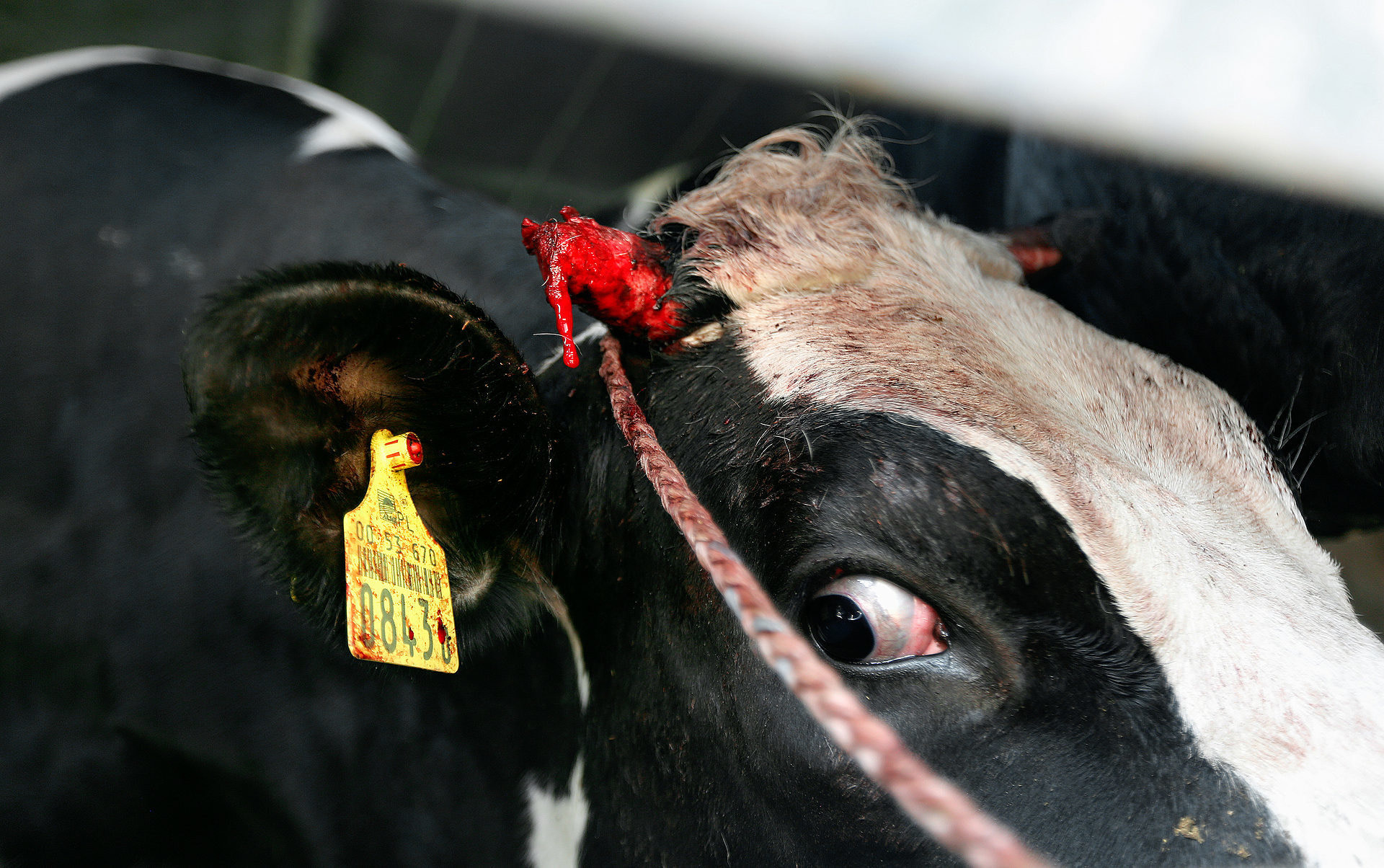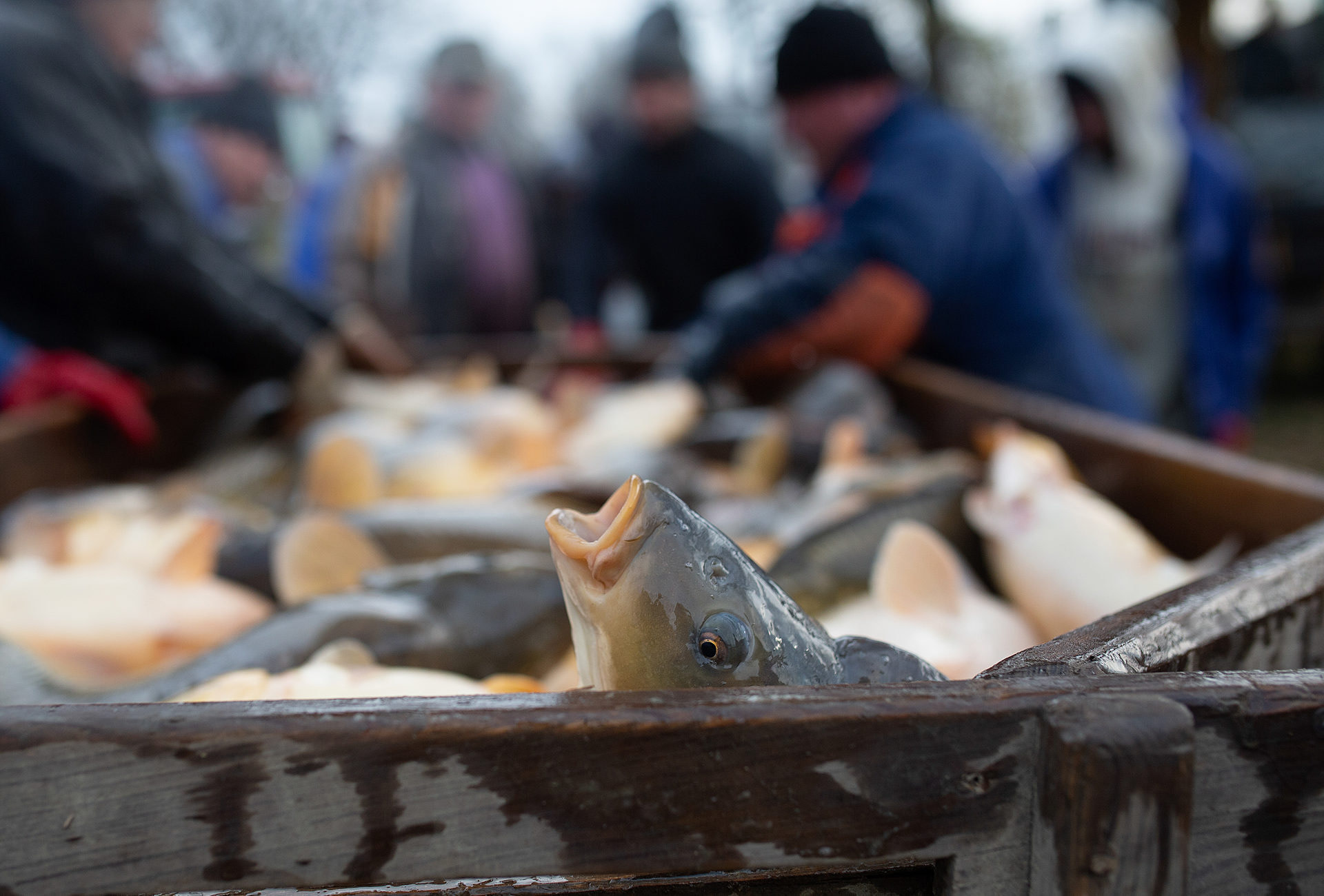We Animals Contributor, Andrew Skowron / Photo credit: Bogna Wiltowska
[Content warning: Contains confronting images and/or video footage]
Editor’s Note: This post was originally published on May 24, 2018 and has been updated for accuracy and to include new visuals.
Animal photojournalist Andrew Skowron worked as a photo reporter in the media for 14 years, followed by eight years focusing on photographing farmed animals, starting with a major project on live animal transport. After quitting media work altogether, he decided to dedicate his photography to the fight for animal rights, working for two animal advocacy organizations in Poland, Otwarte Klatki and Anima International. Through his work, Andrew is committed to revealing how animals are treated, the conditions they live in, and how they are transported and ultimately killed for human consumption. Through his images, Andrew tries to “make visible the blurry line between being a living being and a product.” His work has been published by National Geographic Polska, Bored Panda, Publico, Gaia and other international titles, and are used in animal rights campaigns globally. Andrew is also one of the 40 contributing photographers to our book HIDDEN: Animals in the Anthropocene.
We sat down with Andrew to hear about his current work in Europe and what drives him to capture such startling images of animals trapped in factory farming.
Interview by We Animals.
All images by Andrew Skowron.
Rescued arctic fox Maciek takes a bite of his first-ever pear at a Polish animal sanctuary after being saved from the fur industry by the animal advocacy organization Open Cages (Otwarte Klatki). Maciek was discovered on a fox fur farm in Karski, Poland, with an irreparable open fracture on his left hind paw, resulting in the amputation of his injured limb and adaptation to life on three legs using his bent tail as a balancing aid. Maciek now resides at the sanctuary in a shared enclosure with vixen Franka, a fellow rescued fox. Psu Braty Animal Sanctuary, Poland, 2020.
Andrew Skowron / We Animals
Which came first for you: animals or photography? Can you tell us a little about your path to where you are today?
Animals always came first. My path to knowledge began with dogs in the city, where no one seemed to mind the sight of a pack of dogs on a housing estate, through to farm animals on my grandparents’ farm, where I learnt empathy without knowing the meaning of the word. It was very selective, because I accepted the whole rural system of breeding. I experienced tangibly the slaughter of pigs, the sight of insemination or the sight of dairy cows tethered in fields. My grandparents respected their animals, which they later killed in order to feed their large family, even though my grandfather, a tough farmer, had a problem with killing a lamb, which was often discussed and explained to me that this was because “the lamb cries.” This is what I remember from my childhood about the image of the Polish countryside, which at the time still had very little in the way of industrial farms, even though my other grandfather worked as a caretaker on a state pig farm at the time of the end of communism in Poland. Over time, the image of the countryside changed in my mind, and I began to reflect, analyse, rebel and disapprove of the image that I had known from my childhood. The punk environment I found myself in hardened my approach to animal rights, and my fascination with the Animal Liberation Front emerged. I was looking for opportunities for radical activism but it was far away and not very tangible. I had no idea what to do with my career, I grabbed my camera and found my place in the media, a few years as a reporter taught me to work in all conditions. By a strange coincidence, I combined my passion, my learned skills and my convictions into a whole. Photography became a tool for me to get involved full-time in the fight for animal rights, and that continues to this day. Nowadays it is difficult for me to say when I am working and when I am not.
The whole journey I have gone through from my childhood to now, all that I have seen and experienced, has a very strong influence on what I do now and how I perceive this animal world.
Ready for slaughter, six-week-old chickens are carelessly caught and packed into crates, a process that often results in injury to wings and legs.
Andrew Skowron / HIDDEN / We Animals
What’s happening in animal photojournalism in Poland?
The subject is practically unknown, even ignored in reportage photography circles; I think it is still a taboo subject here, although I often get a positive response when talking about my work. For many photojournalists outside the field of animal rights, it is strange that you can only deal with such a subject in reportage. However, I often get the impression that there is no desire to show such subjects in galleries or photo festivals in Poland, apart from the target group of viewers who are involved in animal rights issues. On a number of occasions, the Polish media have raised the subject of animal photojournalism as something atypical with a friendly attitude towards the creators, and more emphasis has been placed on publishing material from ongoing investigations on factory farms. In this case, the media were not indifferent to animal suffering and there was always a journalist willing to cooperate. Animal photojournalism is concentrated around investigative activists working for several organisations in Poland, and is most evident in the publication of investigations.
Is there any particular visual you’ve created that you think represents your work and what you’d like to communicate to the world particularly well? Tell us why.
Any photograph showing suffering is a global message of injustice to animals. I can point to a photograph of two representatives of animal destruction, but will it be fair? Will these two be able to represent all the animals?
A young fox leaning against the wall of its cage and looking straight into the lens, a photograph taken during an intervention on a fur farm at the moment when people become the master of life and death, when people have to decide who to give life to. The photo becomes either a symbol of a new life outside the farm or a last goodbye. More than once I returned to this farm which had been closed a few years earlier, often stopping at the same empty cage. What happened to the fox…
A silver fox paws at a tiny cage left open to the elements on a neglected fur farm. The inability to scratch and lack of care led to nail overgrowth. The foxes were removed due to welfare violations and the farm owners were accused of animal abuse. As of 2021 the lawsuit is ongoing. Goliszow, Poland, 2017.
Andrew Skowron / We Animals
The second photo of a piglet that is getting to know his little world in a metal pen on a few metres of an industrial pig farm. The photo shows his hermetic sad world confined by metal walls, there is no substitute there of life outside of metal space.
And maybe one more photo: it is a picture of a fox that died while biting into a cage while looking for an escape from a farm where foxes were dying of hunger and thirst. This picture shows what humanity is capable of. It is difficult to talk about what I want to convey to the world, with the thought that tomorrow I will pack my rucksack and leave to document yet another animal atrocity perfectly prepared by the human species. Maybe the world should make it so that I don’t have to pack my rucksack tomorrow.
On assignment for We Animals in 2022 you were at the Polish border documenting the stories of humans and animals in the Ukraine seeking refuge from the Russian invasion. Can you tell us a bit about your experience documenting this story?
I have before my eyes the image of a frightened woman giving a blanket to an exhausted dachshund on a bed in an empty art gallery converted into a reception area, stroking their head. I remember a woman sharing a small portion of soup with her dog, provided by volunteers at a railway station in a Polish city; and a little boy saying how wonderful his “kitty” was, which he packed in a metal cage used for fishing as he did not want to leave them in the war zone. The cat travelled 1,050 km by train with him. Had it not been for the war, many would have regarded these methods of transport as unethical, in this case they were justified acts of love and to save his friend.
War refugees from Ukraine with their animals rest at the train station in Katowice. They came to Lviv by train from Kharkiv. From Lviv to Katowice by another train. The animals are provided with food and veterinary care. Poland, 2022.
Andrew Skowron / We Animals
The sight of the Ukrainian refugees, their dedication and desperation to save the animals gave me a lot to think about. I spent several dozen hours at railway stations, reception areas and border crossings. I met a mother with a child and two cats who were escaping from bombed Kharkiv. By the time the woman reached Poland, she had spent seven or eight days travelling. That is how long my project took. The difference was that I was not fleeing and I could always return home. They only had a few suitcases, cats and no prospect of returning. Most of the dogs I saw were small. Some of them were tangled up on leashes, while others could only be seen with their heads sticking out from under their humans’ jackets. Many of them were wearing colourful clothes. In the station halls they slept cuddled up to their humans, and in the reception areas they rested on beds with their families. I remember a boy and his girlfriend at customs in Przemyśl turned up with a dachshund, a labrador and three cages with several parrots inside. With no plans, no contacts, they found themselves in Poland, where they had never been. I asked where they were going, they replied “we don’t know.” All they knew was that they were away from the war and most importantly that they were all together. Cats and dogs mingled with hamsters, mice, guinea pigs, parrots, rats and rabbits. Each animal owner was immediately helped by volunteers from pro-animal organisations. They were supplied with food, leashes, professional containers, there were also veterinary outlets to vaccinate and chip animals, and owners were informed about procedures in the European Union. Pro-animal activists were as involved as organisations helping refugees.
Ukraine’s refugees looked on with tears in their eyes at such selfless help to animals. At the humpback crossing in Medyka, activists from the German Tierschutzbund organisation set up a field veterinary surgery. Here, the most tired and stressed animals were helped with vitamins, supplements and tranquilisers. My work did not always bring me into direct contact with them; sometimes I observed their intimate situations with the animals from behind the scenes.
I have before my eyes a woman warming a dog by the fire. Two brothers from Kiev with a mouse in a small container, to which they made a house out of a light bulb box. An elderly couple with two dogs and nine cats in containers, which they pushed from the border crossing to the bus in a shopping trolley from Biedronka. I don’t know which story is more special, each one, whether of a mouse, hamster or cat, is a separate drama of suffering. It is a demonstration of true love, friendship and devotion to one’s pets. It is a test that the guardians of these animals passed with flying colours. It was a great difficulty to photograph the war-weary drama of people being greeted at the border with Ukraine by a crowd of photojournalists and TV cameras. However, when I made a direct connection with the refugees and the question was asked not about the war, but whether I could photograph their sabake (dog) or kishkas (cat), they responded with smiles and interest. Talking about animals together, despite the language barrier, sometimes lasted several minutes. These minutes allowed them to forget about the war for a while.
Tatiana, a young Ukrainian refugee, carries two small dogs though the train station in Kraków. They escaped from Kharkiv and are heading to Spain. Poland, 2022.
Andrew Skowron / We Animals
You were recently on assignment with Anima International and Humánny Pokrok documenting intensive egg production in Slovakia. Much of the EU has banned battery cages on egg farms however, as of 2022, up to 80 percent of Slovakia’s laying hens remain housed in traditional battery cage systems. Can you tell us a bit about your experience documenting this issue and what’s been done by local NGOs to tackle it?
The investigative team of the joint forces of Open Cages and Anima International have helped other organisations in Europe and Asia on many occasions, and this time it was a quick trip next door to Slovakia to support Humánny Pokrok and their involvement in the European End the Cage Age campaign.
Together with their activists, we documented the hen situation on one of the largest laying hen farms in the country. The hens, as on most farms in Europe, were kept in dozens over several tiers, crowded and stripped of their feathers as a result of intensive exploitation. The suffering of laying hens knows no bounds; in most countries it looks the same and takes place in this system of breeding. Our investigation was complementary to the undercover investigation carried out by Humánny Pokrok a few weeks earlier. Our joint action strengthened their national campaign in which they tabled a draft ban in parliament, and I hope that our support for their involvement will lead to a ban in Slovakia.
A laying hen pokes her head through the bars of a cramped battery cage on a Slovakian intensive egg production farm. Feed is delivered to the hens utilizing a conveyor belt, and they must push their heads through the bars to eat. This farm keeps tens of thousands of hens in multiple metres-long rows of cages stacked 3 levels high. When the hens can no longer produce enough eggs, they are taken to slaughter and replaced with a new young flock. Velky Lapas, Slovakia, 2022.
Andrew Skowron / We Animals
A thick layer of chicken droppings coats a conveyor belt that runs underneath several dozen cages containing laying hens on an intensive egg production farm in Slovakia. The conveyor runs under a metal grate in the floor and transports the hens’ droppings to a tank outside. Velky Lapas, Slovakia, 2022.
Andrew Skowron / We Animals
Who inspires your work? Do you have any top photography influences?
I am inspired by all the photojournalists who have focused on animal rights photography. New investigative material fuels and inspires me to keep going. It’s difficult to single out individuals and they should all stand in the same line for what they do. If I had to name names, I wouldn’t leave out Aitor Garmendia or Jo-Anne McArthur, who inspired me from the very beginning of my work.
When preparing for a field assignment, what’s your go-to camera bag kit?
Every time I go out, I always think I’ve forgotten something and I’m always looking for something! As for the backpack, I have always worked on Canon kit, more recently on a Canon R6 mirrorless, lenses: Canon RF 15-35 2.8, 70-200 2.8, 50 RF 1.2, 2x led flash, battery pack, memory cards, Osmo and GoPro camera, overalls and lens cleaning wipes. Sometimes I take a drone, binoculars, bush disguise and red headlamp. Depending on the subject, the interior of the backpack is supplemented or minimised.
Many people would find it too difficult to photograph what you do. What helps you overcome the difficulties inherent with this kind of photojournalism?
Any photojournalism involving human or animal suffering is difficult. I would put our emotions on a par with photojournalists working in a war zone, we also have our battlefield, only on ours we photograph the defeated. My anger at accepting the suffering of animals allows me to put empathic thinking to one side; this does not mean that empathy disappears, it is simply muted. At work, I have to switch off unnecessary thoughts and learn to look at things directly, without unnecessary emotions. Social changes, legislation and the punishment of perpetrators after the publication of our investigations are another driving force. Why does the majority of society seem to accept what happens at factory farms and slaughterhouses? Sometimes it’s easier not to see, not to know and not to face the problem – that way is better to live but I can’t do that.
How much creativity can you as a photographer bring to a scene? You’re reporting as a journalist, but how much are you also trying to include your perspective as an eye-witness, as well as your own creative expression?
Creativity doesn’t quite fit in with the reporting I do, I associate it more with art and artistry. I often have a problem with us photojournalists being described as artists, I don’t like the word in this context, but that’s just my feeling. The documentary photographs I work on are dirty and raw, it’s a narrative that I show in a 1:1 ratio. These are not artistic images to be savoured, they are brutal truths to educate and make us think, leading to social change. Even the use of photoshop is negligible, the suffering cannot be edited by photoshop. In expressive photography, it is all about emotion and making the viewer think and experience. Our narrative is first and foremost the handling of suffering and sadness, which is supposed to provoke emotion and reflection. We have to look at the world from two sides, as a photographer and as a person. We have to be aware and sensitive of what we do and what we want to convey. It is always good to have this “key” to the subject we are dealing with. What is most important is the truth and authenticity in the communication of a given photograph.
A dead chick lays amidst other birds in various stages of hatching at a hatchery in Ukraine. Many chicks die in the egg before they hatch and they will be disposed of in a grinder along with the weak and ailing chicks from the brood. Ukraine, 2017.
Andrew Skowron / We Animals
If you could issue an invitation to other photographers to take up animal photojournalism, what would you say?
Every photojournalist should consciously make this choice. If they are not indifferent to the fate of animals, believe that with their skills and dedication are able to be in the right places and show successive stories, then they should do so. We are well aware that this field of work is not for everyone and this is understandable. It is up to each individual to decide whether to do it, if someone wants to, they already know that.
If you could issue an invitation to the media to include the work of animal photojournalists, what would you say?
Publish our material, be open to our activities. Don’t block our reports by hiding the brutality of the images; suffering cannot be erased by a bleached photo. Cooperate in the creation and publication of investigations. Your help is indispensable: united forces can help animals, influence public opinion and thus bring about changes on a political level.
Calves drink milk together from a feeder through artificial nipples on a Polish dairy farm. These calves are several months of age and live in group housing after spending their first few weeks in individual calf hutches. These calves are fed twice daily and are not yet divided by gender. Poland, 2020.
Andrew Skowron / We Animals
What’s next for you in your work? Are there any particular animal stories you’re particularly compelled to document?
I certainly won’t have a long holiday. There is a lot of work ahead of me and the investigative team I work with. It is too early to give official information about work on further projects. I am sure that my work will focus on the leading EU campaigns on the subject: End the Cage Age. I am in the process of working on a theme related to aquaculture. I am continuously monitoring animal transport in my country and the problem of fur farms. Material will be published as it becomes available.
Carp are scooped up with a landing net so they can be moved to the sorting area where they will be segregated. Once sorted, they are moved to a storage pond to be sold. Poland, 2017.
Andrew Skowron / We Animals
Rescue donkey Curro peeks over the fence to greet visitors entering The Animal Academy sanctuary in Fuerteventura, Spain. Curro was a family pet in a house until his size meant they could no longer care for him – in fact, Curro still prefers the company of humans to his fellow donkeys! Spain, 2022.
Andrew Skowron / We Animals
Get in touch with Andrew Skowron and follow his work:
Interview by We Animals.
All images by Andrew Skowron.
Explore more of Andrew’s visuals via our stock collection, including images from his time documenting intensive egg production in Slovakia, modern-day dairy farming in Poland and Ukraine, pig slaughter in Thailand, fur farming and rescued foxes in sanctuary.

